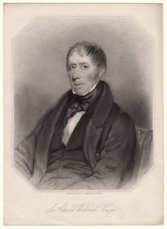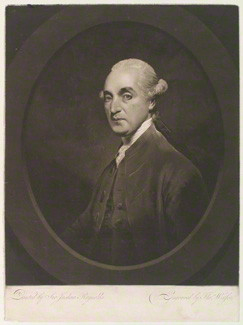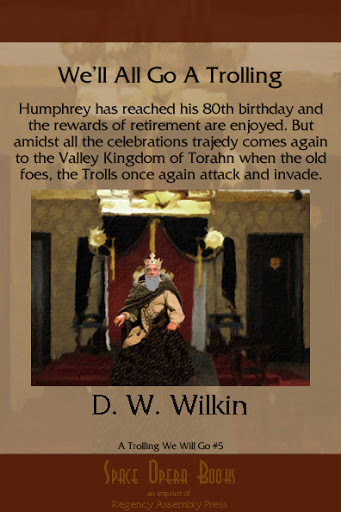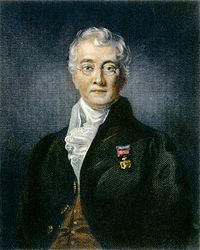D.W. Wilkin's Blog, page 11
December 3, 2016
Space Opera Books Presents A Trolling We Will Go Omnibus:The Latter Years
A Trolling We Will Go Omnibus:The Latter Years
Not only do I write Regency and Romance, but I also have delved into Fantasy.
The Trolling series, is the story of a man, Humphrey. We meet him as he has left youth and become a man with a man’s responsibilities. He is a woodcutter for a small village. It is a living, but it is not necessarily a great living. It does give him strength, muscles.
We follow him in a series of stories that encompass the stages of life. We see him when he starts his family, when he has older sons and the father son dynamic is tested.
We see him when his children begin to marry and have children, and at the end of his life when those he has loved, and those who were his friends proceed him over the threshold into death.
All this while he serves a kingdom troubled by monsters. Troubles that he and his friends will learn to deal with and rectify.
Here are the last two books together as one longer novel.
Trolling, Trolling, Trolling Fly Hides! and We’ll All Go a Trolling.
Available in a variety of formats.
For $5.99 you can get this fantasy adventure.

Barnes and Noble for your Nook
The stories of Humphrey and Gwendolyn. Published separately in: Trolling, Trolling, Trolling Fly Hides! and We’ll All Go a Trolling. These are the tales of how a simple Woodcutter who became a king and an overly educated girl who became his queen helped save the kingdom of Torahn from an ancient evil. Now with the aid of their children and their grandchildren.
Long forgotten is the way to fight the Trolls. Beasts that breed faster than rabbits it seems, and when they decide to migrate to the lands of humans, their seeming invulnerability spell doom for all in the kingdom of Torahn. Not only Torahn but all the human kingdoms that border the great mountains that divide the continent.
The Kingdom of Torahn has settled down to peace, but the many years of war to acheive that peace has seen to changes in the nearby Teantellen Mountains. Always when you think the Trolls have also sought peace, you are fooled for now, forced by Dragons at the highest peaks, the Trolls are marching again.
Now Humphrey is old, too old to lead and must pass these cares to his sons. Will they be as able as he always has been. He can advise, but he does not have the strength he used to have. Nor does Gwendolyn back in the Capital. Here are tales of how leaders we know and are familiar with must learn to trust the next generation to come.
Feedback
If you have any commentary, thoughts, ideas about the book (especially if you buy it, read it and like it
December 2, 2016
Regency Personalities Series-Ackermann’s Repository of Arts
Regency Personalities Series
In my attempts to provide us with the details of the Regency (I include those who were born before 1811 and who died after 1795), today I continue with one of the many period notables.
Ackermann’s Repository of Arts
1809 – December 1828
Ackermann’s Repository of Arts was an illustrated British periodical published from 1809-1829 by Rudolph Ackermann. Although commonly called Ackermann’s Repository, or, simply Ackerman’s, the formal title of the journal was Repository of arts, literature, commerce, manufactures, fashions, and politics, and it did, indeed cover all of these fields. In its day, it had great influence on English taste in fashion, architecture, and literature. Ackermann employed Frederic Shoberl from the third issue in 1809 to 1828 when Shoberl moved on to similar projects.
The last issue of the original Repository, published in December 1828, stated that the following year a new magazine would take its place. This new magazine, titled The Repository of Fashion, focused solely on fashion and was illustrated with a number of hand-colored and black-and-white plates. However, the last known issue of this new periodical was in September 1829. It is believed that soon thereafter, The Repository of Fashion was merged into La Belle Assemblée.


An Unofficial Guide to how to win the Scenarios of Soaked the 1st Expansion for Rollercoaster Tycoon 3
An Unofficial Guide to how to win the Scenarios of Soaked
I have been a fan of this series of computer games since early in its release of the very first game. That game was done by one programmer, Chris Sawyer, and it was the first I recall of an internet hit. Websites were put up in dedication to this game where people showed off their creations, based on real amusement parks. These sites were funded by individuals, an expense that was not necessarily as cheap then as it is now. Nor as easy to program then as it might be to build a web page now.
Prima Books released game guides for each iteration of the game, Rollercoaster Tycoon 1, Rollercoaster Tycoon 2 and Rollercoaster Tycoon 3 (RCT3) but not for the expansion sets. And unlike the first two works, the third guide was riddle with incorrect solutions. As I played the game that frustrated me. And I took to the forums that Atari, the game publisher hosted to see if I could find a way to solve those scenarios that the Prima Guide had written up in error. Not finding any good advice, I created my own for the scenarios that the “Official” Guide had gotten wrong.
Solutions that if you followed my advice you would win the scenario and move on. But if you followed the “Official” version you would fail and not be able to complete the game. My style and format being different than the folks at Prima, I continued for all the Scenarios that they had gotten right as well, though my solutions cut to the chase and got you to the winner’s circle more quickly, more directly.
My contributions to the “Official” Forum, got me a place as a playtester for both expansions to the game, Soaked and Wild. And for each of these games, I wrote the guides during the play testing phase so all the play testers could solve the scenarios, and then once again after the official release to make changes in the formula in case our aiding to perfect the game had changed matters. For this, Atari and Frontier (the actual programmers of the game) placed me within the game itself.
And for the longest time, these have been free at the “Official” Forums, as well as my own website dedicated to the game. But a short time ago, I noticed that Atari, after one of its bankruptcies had deleted their forums. So now I am releasing the Guide for one and all. I have added new material and it is near 100 pages, just for the first of the three games. It is available for the Kindle at present for $2.99.
(Click on the picture to purchase)
Not only are all 9 Scenarios covered, but there are sections covering every Cheat Code, Custom Scenery, the famous Small Park Competition, the Advanced Fireworks Editor, the Flying Camera Route Editor which are all the techniques every amusement park designer needs to make a fantastic park in Rollercoaster Tycoon 3.
Scenarios for Soaked!
1) Captain Blackheart’s Cove
2) Oasis of Fun
3) Lost Atlantis
4) Monster Lake
5) Fountain of Youth
6) World of the Sea
7) Treasure Island
8) Mountain Spring
9) Castaway Getaway


December 1, 2016
Regency Personalities Series-Sir Charles Wetherell
Regency Personalities Series
In my attempts to provide us with the details of the Regency (I include those who were born before 1811 and who died after 1795), today I continue with one of the many period notables.
Sir Charles Wetherell
1770 – 17 August 1846

Charles Wetherell
Sir Charles Wetherell was born in Oxford, the third son of Reverend Nathan Wetherell, of Durham, Master of the University College and Vice-Chancellor of the University of Oxford. His mother was Richarda Croke (1743?-1812), sister of Sir Alexander Croke, of Studley Priory, Oxfordshire.
Wetherell was Member of Parliament for a considerable period, representing Rye from 1812 to 1813, Shaftesbury from 1813 to 1818, Oxford from 1820 to 1826. He was elected MP for Hastings in 1826 but had to stand down when appointed Attorney-General. He represented Plympton Erle from December 1826 to 1830 and Boroughbridge from 1830 to 1832.
He was Solicitor-General between 1824 and 1826 and Attorney General between 20 September 1826 and 27 April 1827 and again between 19 February 1828 and 29 June 1829. In May 1829, Wetherell made a violent speech in opposition to Catholic Emancipation, and was dismissed by the Duke of Wellington. He was Recorder of Bristol during the riots of 1831. From 1835 up to his death in 1846 he was Chancellor of Durham.
Wetherell was twice married, first, in 1826, with his cousin Jane-Sarah-Elizabeth Croke (1804–1831). They had a son, Charles, who died in infancy. In 1838 he married Harriet-Elizabeth, daughter of Colonel Warneford.


Caution’s Heir from Regency Assembly Press-Now available everywhere!
Caution’s Heir is now available at all our internet retailers and also in physical form as well
The Trade Paperback version is now available for purchase here @ $15.99 (but as of this writing, it looks like Amazon has still discounted it 10%)
Caution’s Heir is also available digitally for $4.99 @ the iBookstore, Amazon, Barnes and Noble, Kobo and Smashwords.
The image for the cover is a Cruikshank, A Game of Whist; Tom & Jerry among the ‘Swell Broad Coves.’ Tom and Jerry was a very popular series of stories at the time.
Teaching a boor a lesson is one thing.
Winning all that the man owns is more than Lord Arthur Herrington expects. Especially when he finds that his winnings include the boor’s daughter!
The Duke of Northampshire spent fortunes in his youth. The reality of which his son, Arthur the Earl of Daventry, learns all too well when sent off to school with nothing in his pocket. Learning to fill that pocket leads him on a road to frugality and his becoming a sober man of Town. A sober but very much respected member of the Ton.
Lady Louisa Booth did not have much hope for her father, known in the country for his profligate ways. Yet when the man inherited her gallant uncle’s title and wealth, she hoped he would reform. Alas, that was not to be the case.
When she learned everything was lost, including her beloved home, she made it her purpose to ensure that Lord Arthur was not indifferent to her plight. An unmarried young woman cast adrift in society without a protector. A role that Arthur never thought to be cast as. A role he had little idea if he could rise to such occasion. Yet would Louisa find Arthur to be that one true benefactor? Would Arthur make this obligation something more? Would a game of chance lead to love?
Today, the iBookstore is added, HERE
Get for your Kindle, Here
In Trade Paperback, Here
Digitally from Smashwords, Here
For your Sony Kobo, Here
Or for your Nook, Here
From our tale:
Chapter One
St. Oswald’s church was bleak, yet beautiful all in one breath. 13th century arches that soared a tad more than twenty feet above the nave provided a sense of grandeur, permanence and gravitas. These prevailed within, while the turret-topped tower without, once visible for miles around now vied with mature trees to gain the eye of passers-by.
On sunny days stain-glass windows, paid for by a Plantagenet Baron who lived four hundred years before and now only remembered because of this gift, cast charming rainbow beams across the inner sanctum. And on grey overcast days ghostly shadows danced along the aisle.
As per the custom of parish churches the first three pews were set-aside for the gentry. On this day the second pew, behind the seat reserved for the Marquess of Hroek, who hadn’t attended since the passing of his son and heir, was Louisa Booth his niece and her companion Mrs Bottomworth.
Mrs Bottomworth was a stocky matron on the good side of fifty. Barely on the good side of fifty. But one would not say that was an unfortunate thing for she wore her years well and kept her charge free of trouble. Mrs Bottomworth’s charge was an only child, who would still have been in the schoolroom excepting the fact of the death of her mother some years earlier. This had aged the girl quickly, and made her hostess to her father’s household. The Honourable Hector Booth, third son of the previous Marquess, maintained a modest house on his income of 300 pounds. That was quite a nice sum for just the man and one daughter, with but five servants. They lived in a small, two floor house with four rooms. It should be noted that this of course left two bedchambers that were not inhabited by family members. As the Honourable Mr Booth saved his excess pounds for certain small vices that confined themselves with drink and the occasional wager on a horse, these two rooms were seldom opened.
Mrs Bottomworth had thought to make use of one of the empty rooms when she took up her position, but the Honourable Hector Booth advised and instructed her to share his daughter’s room. For the last four years this is what she had done. When two such as these shared a room, it was natural that they would either become best of friends, or resent each other entirely. Happily the former occurred as Louisa was in need of a confidant to fill the void left in her mother’s absence, and Mrs Bottomworth had a similar void as her two daughters had grown and gone on to make their own lives.
The Honourable Mr Booth took little effort in concerning himself with such matters as he was ever about his brother’s house, or ensconced in a comfortable seat at either the local tavern or the Inn. If those locations had felt he was too warm for them, he would make a circuit of what friends and acquaintances he had in the county. The Honourable Mr Booth would spend an hour or two with a neighbour discussing dogs or hunters, neither of which he could afford to keep, though he did borrow a fine mount of his brother to ride to the hunt. The Marquess took little notice, having reduced his view of the world by degrees when first his beloved younger brother who was of an age between the surviving Honourable Mr Booth had perished shortly after the Marquess’ marriage. Their brother had fallen in the tropics of a fever. Then the Marquess had lost his second child, a little girl in her infancy, his wife but a few years after, and most recently his son and heir to the wars with Napoleon.
This caused the Honourable Mr Booth to be heir to Hroek, a situation that had occurred after he had lost his own wife. With that tragedy, Mr Booth had found more time to make friends with all sorts of new bottles, though not to a degree that it was considered remarkable beyond a polite word. Mr Booth was not a drunkard. He was confronting his grief with a sociability that was acceptable in the county.
Louisa, however, was cast further adrift. No father to turn to. No uncle who had been the patriarch of the family her entire life. And certainly now no feminine examples to follow but her companion and governess, Mrs Bottomworth. That Mrs Bottomworth was an excellent choice for the task was more due to acts of the Marquess, still able to think clearly at the time she was employed, than to the Honourable Mr Booth. Mr Booth was amenable to any suggestion of his elder brother for that man controlled his purse, and as Mr Booth was consumed with grief, while the Marquess had adapted to various causes of grief prior to the final straw of his heir’s death, the Marquess of Hroek clearly saw a solution to what was a problem.
Now in her pew, where once as a young girl she had been surrounded by her cousins, parents, uncles and aunt, she sat alone except for her best of friends. Louisa was full of life in her pew, her cheeks a shade of pink that contrasted with auburn hair, which glistened as sunlight that flowed though the coloured panes of glass touched it from beneath her bonnet. Blue eyes shown over a small straight nose, her teeth were straight, though two incisors were ever so slightly bigger than one would attribute to a gallery beauty painted by Sir Thomas Lawrence.
She was four inches taller than five feet, so rather tall for a young woman, but her genes bred true, and many a girl of the aristocracy was slightly taller than those women who were of humbler origins. Her back was straight and for an observant man, of which there were some few in the county, her figure might be discussed. The wrath though of her uncle the Marquess would not wish to be bourne should it be found out that her form had become a topic amongst the young men. Noteworthy though was that she had a figure that men thought inspiring enough to tempt that wrath, and think on it. A full bosom was high on her chest, below her heart shaped face. She was lean of form, though her hips flared just enough that one could see definition in her torso. Certainly a beauty Sir Thomas’ brushes would wish the honour to meet.
The vicar Mr Spotslet had at one time in his early days in the community, discussed the Sunday sermons with the Marquess. Mr Spotslet had enjoyed long discussions of theology, philosophy, natural history and the holy writ that were then thoughtfully couched in terms to be made accessible by the parish. The lassitude that had overtaken the Marquess had caused those interviews to become shortened and infrequent and as such the sermons suffered, as many were wont to note. There had been dialogues that Mr Spotslet had engaged in with the attendees of his masses. Now he seemed to have lost his way and delivered soliloquies.
This day Mr Spotslet indulged in a speech that talked to the vices of gambling. The local sports, of which the Honourable Mr Booth was an intimate, had raced their best through the village green the previous Wednesday for but a prize of one quid, and this small bet had caused pandemonium when Mrs McCaster had fallen in the street with her washing spread everywhere and trampled by the horses. Not much further along the path, Mr Smith the grocer’s delivery for the vicar himself was dropped by the boy and turned into detritus as that too was stampeded over. A natural choice for a sermon, yet only two of the culprits were in attendance this day. The rest had managed to find reasons to avoid the Mass.
Louisa squirmed a little in her seat the moment she realised that her father had been one of the men that the sermon was speaking of. Was she not the centre of everyone’s gaze at such a time? Her father having refused to attend for some years, and her uncle unable due to his illness. She was the representative of the much reduced family. Not only was it expected that the parish would look to her as the Booth of Hroek, but with her father’s actions called to the attentions of all, it was natural that they look at her again. This time in a light that did not reflect well on her father and she knew that she had no control over that at all.
Mrs Bottomworth, who might have been lightly resting her eyes, Louisa would credit her in such a generous way, came to tensing at the mention of the incident. Louisa did not want to bring her friend to full wakefulness, but Mrs Bottomworth realised what was occurring and the direction that the sermon was taking. Louisa’s companion took her hand and patted it reassuringly.
“Perhaps a social call on Lady Walker?” Mrs Bottomworth suggested as they walked back to the house after services. The house which sat just within the estate boundaries was four hundred feet off the main bridal way that led to Hroek Castle. A small road had been cleared from the gatehouse to the house that Mr Booth now maintained, and this the two women travelled.
Louisa generally appreciated visits such as this as she had gotten older, and certainly several of the adults in the neighbourhood showed a kindly interest in her education and the development of her social manners. “I think I shall go to the castle and read to my uncle.” A task that she had done each day of the last fortnight but one.
“We have not talked, but you and the Marquess had an interview with the doctors.” Mrs Bottomworth had tried to comfort her charge after that, but Louisa had waved her hand and gone to sit quietly under a yew tree that had a grand vista of the park leading to Hroek Castle.
“Uncle will be most lucky if he should be with us come Michaelmas.”
“That will be a sad day when we lose such a friend.” These were words of comfort. Mrs Bottomworth had been well encouraged in her charge by the Marquess but one could not say that they interacted greatly with one another. The Marquess ensured that his brother heeded the suggestions and advisements of Mrs Bottomworth as the Honourable Mr Booth left to his own devices would have kept his daughter in the nursery and would have forgotten to send a governess to provide her with instruction.
“Indeed, my uncle may not have been one of the great men of England, but he is well regarded in the county.” Often with that statement followed the next, “Warmly remembered is it when the Prince Regent came and stayed for a fortnight of sport and entertainment.” This had been many years before, and certainly before any of the tragedies beset the line of the Booths.
“Yes, I have heard it said with great earnestness. But come let us change your clothes and then we shall go up to the great house. I shall have Mallow fetch the gig so we may proceed all the more expeditiously.”
“That would be good, but we will have to use the dogcart. Father was to take the gig to see Sir Mark today, or so he said at breakfast.” Where Louisa knew he would drink the Baronet’s sherry for a couple hours before thinking to return, unless he was asked to stay for dinner.


November 30, 2016
Regency Personalities Series-Andrew Stuart
Regency Personalities Series
In my attempts to provide us with the details of the Regency (I include those who were born before 1811 and who died after 1795), today I continue with one of the many period notables.
Andrew Stuart
1725-1801

Andrew Stuart
Andrew Stuart was the second son of Archibald Stuart of Torrance in Lanarkshire (d. 1767), seventh son and heir of Alexander Stuart of Torrance. His mother, Elizabeth, was daughter of Sir Andrew Myreton of Gogar, bart.
Andrew studied law, and became a member of the Scottish bar. He was engaged by James, sixth duke of Hamilton, as tutor to his children, and through his influence was in 1770 appointed Keeper of the Signet of Scotland. When the famous Douglas lawsuit arose, in which the Duke of Hamilton disputed the identity of Archibald James Edward Douglas, first baron Douglas, and endeavoured to hinder his succession to the family estates, Stuart was engaged to conduct the case against the claimant. In the course of the suit, which was finally decided in the House of Lords in February 1769 in favour of Douglas, he distinguished himself highly, but so much feeling arose between him and Edward Thurlow (afterwards Lord Thurlow), the opposing counsel, that a duel took place. After the decision of the case Stuart in 1773 published a series of Letters to Lord Mansfield (London, 4to), who had been a judge in the case, and who had very strongly supported the claims of Douglas. In these epistles he assailed Mansfield for his want of impartiality with a force and eloquence that caused him at the time to be regarded as a worthy rival to Junius.
From 1777 to 1781 he was occupied with the affairs of his younger brother, Colonel James Stuart (d. 1793), who had been suspended from his position by the East India Company for the arrest of Lord Pigot, the governor of the Madras presidency. He published several letters to the directors of the East India Company and to the secretary at war, in which his brother’s case was set forth with great clearness and vigour. These letters called forth a reply from Alexander Dalrymple.
On 28 October 1774 Stuart was returned to parliament for Lanarkshire, and continued to represent the county until 1784. On 6 July 1779, under Lord North’s administration, he was appointed to the Board of Trade in place of Bamber Gascoyne, and continued a member until the temporary abolition of the board in 1782. On 19 July 1790 he re-entered parliament, after an absence of six years, as member for Weymouth and Melcombe Regis, for which boroughs he sat until his death.
On 23 March 1796, on the death of his elder brother, Alexander, without issue, Andrew succeeded to the estate of Torrance, and on 18 January 1797 on the death of Sir John Stuart of Castlemilk, Lanarkshire, he succeeded to that property also. In 1798 he published a Genealogical History of the Stewarts (London, 4to), in which he contended that, failing the royal line (the descendants of Stewart of Darnley), the head of all the Stuarts was Stuart of Castlemilk, and that he himself was Stuart of that ilk, heir male of the ancient family. This assertion provoked an anonymous rejoinder, to which Stuart replied in 1799. He died in Lower Grosvenor Street, London, on 18 May 1801, without an heir male. He married Margaret, daughter of Sir William Stirling of Ardoch, bart. After his death in 1804 she married Sir William Johnson Pulteney, fifth baronet of Wester Hall. By her Stuart had three daughters. The youngest, Charlotte, in 1830 married Robert Harington, younger son of Sir John Edward Harington, eighth baronet of Ridlington in Rutland; through her, on the death of her elder sisters, the estate of Torrance descended to its present [1898] occupier, Colonel Robert Edward Harington-Stuart, while Castlemilk reverted to the family of Stirling-Stuart, descendants of William Stirling of Keir and Cawder, who married, in 1781, Jean, daughter of Sir John Stuart of Castlemilk.
Andrew Stuart’s portrait was painted by Reynolds and engraved by Thomas Watson.


RAP’s has Beggars Can’t Be Choosier
One of the our most recent Regency Romances.
Beggars has won the prestigious Romance Reviews Magazine Award for Outstanding Historical Romance:
It has also been nominated for the 2015 RONE Awards in the category of Historical:Post Medieval sponsored by InD’Tale Magazine.

It is available for sale and I hope that you will take the opportunity to order your copy.
For yourself or as a gift. It is now available in a variety of formats. For $3.99 you can get this Regency Romance for your eReader. A little more as an actual physical book.
When a fortune purchases a title, love shall never flourish, for a heart that is bought, can never be won.
The Earl of Aftlake has struggled since coming into his inheritance. Terrible decisions by his father has left him with an income of only 100 pounds a year. For a Peer, living on such a sum is near impossible. Into his life comes the charming and beautiful Katherine Chandler. She has a fortune her father made in the India trade.
Together, a title and a fortune can be a thing that can achieve great things for all of England. Together the two can start a family and restore the Aftlake fortunes. Together they form an alliance.
But a partnership of this nature is not one of love. And terms of the partnership will allow both to one day seek a love that they both deserve for all that they do. But will Brian Forbes Pangentier find the loves he desires or the love he deserves?
And Katherine, now Countess Aftlake, will she learn to appreciate the difference between happiness and wealth? Can love and the admiration of the TON combine or are the two mutually exclusive?
Purchase here:Amazon Kindle, Barnes and Noble Nook, Kobo, Smashwords, iBooks, & Trade Paperback
Feedback
If you have any commentary, thoughts, ideas about the book (especially if you buy it, read it and like it
November 29, 2016
Regency Personalities Series-Thomas Pelham 1st Earl of Chichester
Regency Personalities Series
In my attempts to provide us with the details of the Regency (I include those who were born before 1811 and who died after 1795), today I continue with one of the many period notables.
Thomas Pelham 1st Earl of Chichester
28 February 1728 – 8 January 1805
Thomas Pelham 1st Earl of Chichester was the son of Thomas Pelham and his wife Annetta, daughter of wealthy merchant George Bridges (d.1714) of Pera Constantinople by his wife Anetta, a local girl. Sir John Pelham, 3rd Baronet, was his great-grandfather and Thomas Pelham-Holles, 1st Duke of Newcastle, and Henry Pelham his first cousins once removed.
Pelham was elected to the House of Commons for Rye in 1749, a seat he held until 1754, and then represented Sussex until 1768. He served as a Commissioner of Trade and Plantations from 1754 to 1761, as a Lord of the Admiralty from 1761 to 1762 and as Comptroller of the Household from 1765 to 1774 and was admitted to the Privy Council in 1765.
In 1768 Pelham succeeded his cousin the Duke of Newcastle as second Baron Pelham of Stanmer according to a special remainder in the letters patent. He also inherited the Pelham baronetcy created in 1611. Pelham also served as Surveyor-General of Customs of London from 1773 to 1805 and as Keeper of the Great Wardrobe from 1775 to 1782. In 1801 he was created Earl of Chichester.
Lord Chichester married Anne Frankland, daughter of Frederick Meinhardt Frankland, in 1754. They had three sons and three daughters. All three daughters and one son predeceased him. His third son the Right Reverend the Hon. George Pelham became Bishop of Bristol, Exeter and Lincoln. Lord Chichester died in January 1805, aged 76, and was succeeded in his titles by his eldest son Thomas, who became a prominent politician. Lady Chichester died in 1813.


Conclusion of the Trolling Series-We’ll All Go A Trolling
We’ll All Go A Trolling Not only do I write Regency and Romance, but I also have delved into Fantasy.
The Trolling series is the story of a man, Humphrey. We meet him as he has left youth and become a man with a man’s responsibilities.
We follow him in a series of stories that encompass the stages of life. We see him when he starts his family, when he has older sons and the father son dynamic is tested.
We see him when his children begin to marry and have children, and at the end of his life when those he has loved, and those who were his friends proceed him over the threshold into death.
All this while he serves a kingdom troubled by monsters. Troubles that he and his friends will learn to deal with and rectify. It is now available in a variety of formats.
For $2.99 you can get this fantasy adventure.

Barnes and Noble for your Nook
King Humphrey, retired, has his 80th birthday approaching. An event that he is not looking forward to.
A milestone, of course, but he has found traveling to Torc, the capital of the Valley Kingdom of Torahn, a trial. He enjoys his life in the country, far enough from the center of power where his son Daniel now is King and rules.
Peaceful days sitting on the porch. Reading, writing, passing the time with his guardsmen, his wife, and the visits of his grandson who has moved into a manor very near.
Why go to Torc where he was to be honored, but would certainly have a fight with his son, the current king. The two were just never going to see eye to eye, and Humphrey, at the age of 80, was no longer so concerned with all that happened to others.
He was waiting for his audience with the Gods where all his friends had preceded him. It would be his time soon enough.
Yet, the kingdom wanted him to attend the celebrations, and there were to be many. So many feasts and fireworks he could not keep track, but the most important came at the end, when word was brought that the Trolls were attacking once more.
Now Humphrey would sit as regent for his son, who went off to fight the ancient enemy. Humphrey had ruled the kingdom before, so it should not have been overwhelming, but at eighty, even the little things could prove troublesome.
Feedback
If you have any commentary, thoughts, ideas about the book (especially if you buy it, read it and like it
November 28, 2016
Regency Personalities Series-Sir Charles Bell
Regency Personalities Series
In my attempts to provide us with the details of the Regency (I include those who were born before 1811 and who died after 1795), today I continue with one of the many period notables.
Sir Charles Bell
12 November 1774 – 28 April 1842

Charles Bell
Sir Charles Bell was born in Edinburgh the son of the Rev William Bell, a clergyman of the Episcopal Church of Scotland, who died in 1779 when Bell was a small child. Bell grew up in Edinburgh, attending the High School (1784-8) and Edinburgh University, where he took his medical degree in 1798. He conducted his surgical training as assistant to his elder brother John Bell.
He and his brother were artistically gifted, and together they taught anatomy and illustrated and published two volumes of A System of Dissection Explaining the Anatomy of the Human Body. Bell’s career was characterized by the accumulation of quite extraordinary honours and achievements – and by acrimonious disputes unusual even by the standards of medicine during the Regency.
Shortly after his graduation Bell was admitted to the Royal College of Surgeons in Edinburgh, where he operated and taught anatomy. He and his brother published two additional volumes of their anatomical treatise in 1802 and 1804. Some aspects of his success, however, led to the jealous opposition of local physicians, and he was barred from practice at the Edinburgh Royal Infirmary. He then moved to London in 1804, where he set up a private surgery and school of anatomy. From 1812 to 1825, together with his brother, Bell ran the Great Windmill Street School of Anatomy, which had been founded by the anatomist William Hunter. He also served as a military surgeon, making elaborate recordings of neurological injuries at the Royal Hospital Haslar and famously documenting his experiences at Waterloo in 1815, where the anatomist Robert Knox commented very negatively on Bell’s surgical abilities; (the mortality rate of amputations carried out by Bell ran at about 90%). Bell was instrumental in the creation of the Middlesex Hospital Medical School, and became, in 1824, the first professor of Anatomy and Surgery of the College of Surgeons in London. In 1829, the Windmill Street School of Anatomy was incorporated into the new King’s College London. Bell was invited to be its first professor of physiology, but resigned shortly afterwards. Wishing to return to Scotland, he accepted in 1836 the position of Professor of Surgery at the University of Edinburgh.
He was made a Knight of the Royal Guelphic Order in 1833.
Bell died at Hallow Park near Worcester in the Midlands, while travelling from Edinburgh to London, in 1842.
He is buried in Hallow Churchyard near Worcester.
Bell was elected a Fellow of the Royal Society of Edinburgh on 8 June 1807, on the nomination of Robert Jameson, William Wright and Thomas Macknight. He served as a Councillor of the RSE from 1836-9.
He was elected a Fellow of the Royal Society of London on 16 November 1826, was knighted in 1831 and, like Sir Richard Owen, was elected a foreign member of the Royal Swedish Academy of Sciences.
Charles Bell was a prolific author. Shortly after arriving in London, he set his sights on the Chair of Anatomy at the Royal Academy, and, in furtherance of this career goal, he published Essays on The Anatomy of Expression in Painting (1806), later re-published as Essays on The Anatomy and Philosophy of Expression in 1824. In this work, Bell followed the principles of natural theology, asserting the existence of a uniquely human system of facial muscles in the service of a human species with a unique relationship to the Creator. After the failure of his application (Sir Thomas Lawrence, later President of the Royal Academy, described Bell as “lacking in temper, modesty and judgement”), Bell turned his attentions to the nervous system.
Bell published detailed studies of the nervous system in 1811, in his privately circulated book An Idea of a New Anatomy of the Brain. He described his experiments with animals and later emphasised how he was the first to distinguish between sensory and motor nerves. This essay is considered by many to be the founding stone of clinical neurology. However, Bell’s original essay of 1811 did not actually contain a clear description of motor and sensory nerve roots as Bell later claimed, and he seems to have issued subsequent incorrectly dated revisions with subtle textual alterations.
Bell’s studies on emotional expression played a catalytic role in the development of Darwin’s considerations of the origins of human emotional life; and Darwin very much agreed with Bell’s emphasis on the expressive role of the muscles of respiration. Darwin detailed these opinions in his The Expression of the Emotions in Man and Animals (1872), written with the active collaboration of the psychiatrist James Crichton-Browne. Bell was one of the first physicians to combine the scientific study of neuroanatomy with clinical practice. In 1821, he described in the trajectory of the facial nerve and a disease, Bell’s Palsy which led to the unilateral paralysis of facial muscles, in one of the classics of neurology, a paper delivered to the Royal Society entitled On the Nerves: Giving an Account of some Experiments on Their Structure an Functions, Which Lead to a New Arrangement of the System.
Bell also combined his many artistic, scientific, literary and teaching talents in a number of wax preparations and detailed anatomical and surgical illustrations, paintings and engravings in his several books on these subjects, such as in his book Illustrations of the Great Operations of Surgery: Trepan, Hernia, Amputation, Aneurism, and Lithotomy (1821). He wrote also the first treatise on notions of anatomy and physiology of facial expression for painters and illustrators, titled Essays on the Anatomy of Expression in Painting (1806). In 1833 he published the fourth Bridgewater Treatise, The Hand: Its Mechanism and Vital Endowments as Evincing Design.









